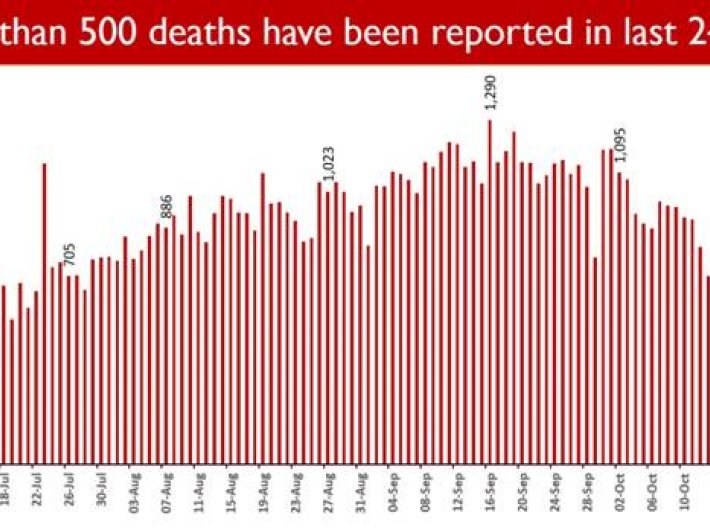14 states/UTs have that ratio under 1%, Less than 500 deaths reported in 24 hours
The annual festive season has brought good news for India: the country’s case fatality ratio has gone down to touch 1.5 percent, and the number of deaths per day has dipped below 500 in the 24 hours to Monday morning – bringing the situation closer to the number before the lockdown was imposed in March.
India has one of the lowest fatality rates in the world. The Case Fatality rate is the lowest since March 22 – the day of the voluntary shutdown – and is continuously declining. Fourteen states and UTs have a CFR lower than 1%.
The focused efforts of the centre and state/UT governments on effective clinical management of the hospitalized cases have ensured the drop in the Fatality Rate, the health ministry said in a bulletin. With effective containment strategy, aggressive testing and standardized clinical management protocols based on holistic Standard of Care protocol across government and private hospitals, the number of new deaths has significantly dipped, the ministry said.
In the 24-hour period under review, only 480 deaths were reported in the country. (That takes the total toll so far to 1,19,014.) Among the fatalities, nearly 80% are concentrated in ten states/UTs. More than 23% of new fatalities reported are from Maharashtra (112 deaths).
The number of fresh infections remained on the downslide with 45,148 cases registered. This is the lowest since July 22 when 37,000 new cases were added. The number of active cases in the country has gone further down to 6,53,717. This is merely 8.26% of the total positive cases of the country standing at 6,53,717. This is the lowest since August 13 when eth active cases were 6,53,622.
As many as 59,105 people recovered during the 24 hours, taking the number of total recoveries to 71,37,228 (90.23 percent).
About 78% of the new recovered cases are observed to be concentrated in 10 States/UTs. Karnataka has contributed the maximum to the single day recoveries with more than 10,000 cases followed by Kerala with more than 7,000 cases.
Some 82% of new confirmed cases are from 10 States and UTs. Kerala and Maharashtra contribute maximum to the new confirmed cases with more than 6,000 cases each followed by Karnataka, Delhi and West Bengal with more than 4,000 cases.
As part of the Covid management and response policy, there has been a sharp focus of the central government on not only containing the Covid, but to reduce deaths and to save lives by providing quality clinical care to the critical and severe patients of Covid. Collaborative efforts of the union and state/UT governments have resulted in strengthening of the health facilities across the country. As many as 2,218 dedicated Covid hospitals are providing quality medical care.
A unique initiative to build the capacities of the ICU doctors in clinical management of critical patients towards reducing the fatality, e-ICU has been started by AIIMS, New Delhi. Twice a week, on Tuesdays and Fridays, tele/video -consultation sessions are held by knowledge and domain experts for the doctors manning ICUs in the State hospitals. These sessions started from 8th July 2020.
Till date, 25 tele-sessions have been held, and 393 institutions across 34 States/UTs have participated in them.
To further build the ICU/clinical management capacities of doctors for treatment of critical patients, AIIMS New Delhi in collaboration with the Health Ministry has developed FAQs. These have been posted on the MoHFW website and can be accessed at:
Also, many states have conducted the population surveys to map and identify the vulnerable population like the elderly, pregnant women and those with co-morbidities. This, with the help of technological solutions like Mobile Apps, has ensured keeping the high-risk population under continuous observation, thus aiding early identification, timely clinical treatment and reducing fatalities. At the ground level, frontline health workers like ASHAs and ANMs have done a commendable job of managing the migrant population and to enhance awareness at the community level.
